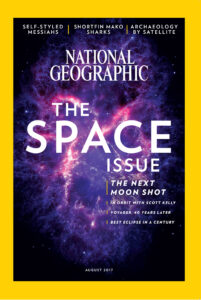by Kerry Torpey on February 1, 2018
Arts & Entertainment

by Ryan Cox ’18
A&E Staff
The National Geographic Society began in 1888 as a club for elite academics to discuss—you guessed it, geography. On Jan. 27, they celebrated the 130th anniversary of their incorporation, marking almost a century and a half of scientific education and natural preservation. From 33 founding members in Washington, D.C., the Society has become one of the largest nonprofit scientific education institutions in the world.
Gardiner Greene Hubbard was the Society’s first president. His son-in-law and successor was Alexander Graham Bell, who later invented the telephone. Bell’s son-in-law, Gilbert Hovey Grosvenor, was the first editor of the National Geographic magazine. Bell remained such an avid supporter of the National Geographic Society that the Society now awards a medal in his name to significant contributers to geographic research.
In 2004, the National Geographic Society’s headquarters became the first existing building to receive a “green” certification from the U.S. Green Building Council, showing that the Society existed not only to talk about environmental issues but also to be a model for change. Over its 130-year history, they have sponsored many research and exploration initiatives, such as Robert Peary and Matthew Henson’s expedition to the North Pole in 1905, and Jane Goodall’s research on chimpanzees.

In addition to their scientific initiatives, the National Geographic Society is perhaps best known for their media, specifically their magazine. The first issue of the magazine was published in September 1888, just nine months after the society was founded. It was originally created to be distributed as a reward for being a member of the Society. Its now-signature yellow border was not adopted until 1910.
In its monthly issues, National Geographic includes articles on geography, popular science, and world history. It is best known for its photography; Bell first advocated for the use of illustrations in the magazine and National Geographic has since established a trademark high standard for its photographs. Since 2006, the Society has hosted an international photography competition.
In film, the National Geographic Society has sponsored a handful of films on wildlife and environmental protection, most notably March of the Penguins, the critically acclaimed 2005 documentary which won an Academy Award for Best Documentary Feature in 2006.
The National Geographic Society also launched a television channel in 2001 under a partnership with Fox Cable Networks, which highlights the work of leading scientists in wildlife and geography, such as Jane Goodall and Louis Leakey.
These features have propelled Goodall, Leakey, and other scientists to international fame. Prior to their TV channel, the Society aired specials on PBS and other major networks.
In an age where scientific thought is often questioned, it seems as though the National Geographic Society is recognizing their position as a cultural force and using it to combat doubt. Their media outlets and events like the National Geographic Bee help to keep the public aware of the world around them, and informed about the way in which it is changing.